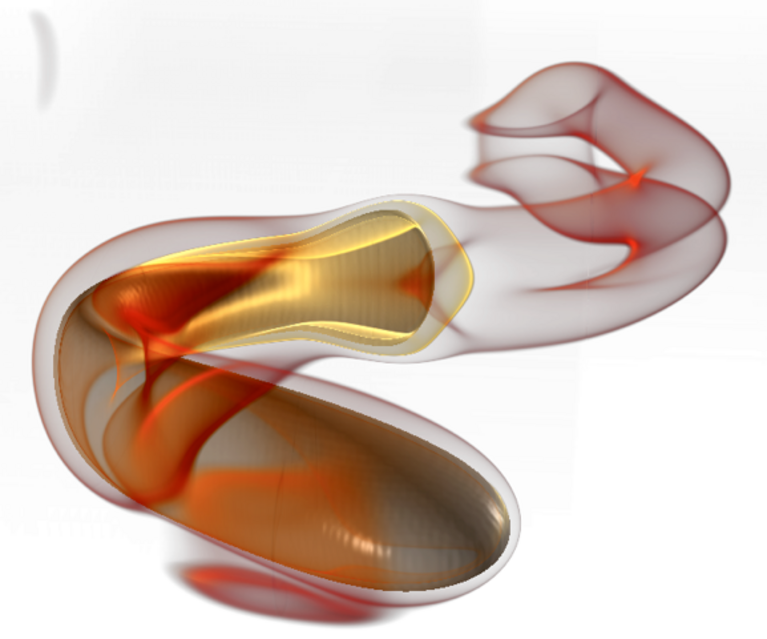May 2, 2012 - by Simone Ulmer
Children playing in the sea never tire of trying to catch the little fish that swim close to shore with their bare hands. The fish sense the danger and can escape by reaching accelerations of up to ten times the gravity acceleration within a fraction of a second. This unimaginable acceleration explains why it is virtually impossible to catch a fish with our bare hands, although they seem to be near and within our grasp. Millions of years of evolution have allowed the larval fish to develop an efficient escape mechanism: they bend their bodies into a ‘C’ shape before they flee away from their predators. Observations and experiments have speculated that this so-called C-start is an optimal design developed over millions of years of evolution.
C-start hypothesis tested using a supercomputer
Petros Koumoutsakos, a professor at the Computational Science & Engineering Laboratory at ETH Zurich, and two of his doctoral students, Mattia Gazzola and Wim Van Rees, have now provided the quantitative confirmation regarding the optimality this C-start hypothesis, which had been missing to date. They have also made further discoveries regarding the hydrodynamics involved in the process.
With the help of algorithms based on the fundamentals of evolution biology, the researchers have used the capabilities of the CSCS supercomputer «Monte Rosa» to reproduce the escape response of zebrafish larvae. Using massive parallel calculations made on tens of thousands of processors over hundreds of hours, within days they reproduced the behaviour that the fish developed during their biological evolution over millions of years. The findings from the study have now been published in the Journal of Fluid Mechanics and selected as a focus article that is accompanied by a commentary (see bibliography).
Approximation to the optimal conditions
The scientists combined a three-dimensional flow simulation with an evolutionary optimization algorithm for their study. The geometrical description of the fish in the simulation corresponded to the shape of the zebrafish larvae, and the movement of the fish was described using eight free parameters, such as the phase of movement and strength of curvature of the fish. The scientists then defined the escape distance as a cost function, and proceeded to use the bio-inspired optimization algorithms to determine the parameters for a maximum escape distance.
To do this, an evolution algorithm changed the parameters in the simulation in an automated fashion. It was shown that the C-start does in fact result in the greatest distance between the prey and the predator when the fish tries to escape. Furthermore, the analyses also showed that the C-start is inefficient in terms of energetics. But this comes as no surprise to Koumoutsakos: “When you are trying to survive, you don’t care about how much energy you need to for your escaping swim.”
The more water is accelerated, the faster the fish
In addition, the scientists quantified the hydrodynamics of the C-start. For this purpose, they analyzed the water mass accelerated by the movement along with the generated vortical flow structures, made visible by marking the water particles. “Using these flow patterns, we are able to measure the forces acting in the system”, explains Koumoutsakos.
The analysis showed that the more water is accelerated by the fish, the more they accelerated themselves. The scientists were surprised to find that the created vortical structures play a lesser role in the escape process than had been assumed thus far. The fish use their entire body to escape (by means of the C-start), so that they can displace much larger volumes of water, to accelerating themselves. The vortical structures they leave in their wakes play a secondary role.
The simulations indicate that, if the physiology of the small zebrafish larvae allowed it, even better results could be obtained with an even more pronounced curvature. This means that corresponding man-made machines that can be bent further than the fish could execute an even faster escape, i.e. even greater acceleration.
Although the concepts of the morphological and kinematic optimization performed in the study are inspired by biological shapes and biological algorithms such as evolution, according to Professor Koumoutsakos they could also be applied for example to wind turbines and energy generation devices that resemble fish. “We believe that present-day questions regarding for instance the structural and kinematic optimization of wind and hydroelectric power stations could be solved using inspiration from Nature”, says Koumoutsakos.
Bibliography
- Gazzola M, Van Rees WM & Koumoutsakos P: C-start: optimal start for larval fish, Journal of Fluid Mechanics (2012) 698, 5-18, DOI: http://dx.doi.org/10.1017/jfm.2011.558
- Triantafyllou MS: Survival hydrodynamics, Journal of Fluid Mechanics (2012) 698, 1-4, DOI: http://dx.doi.org/10.1017/jfm.2012.82
